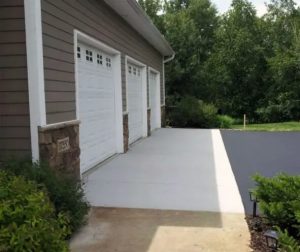What is a Garage Apron & What is a Driveway apron?
- A Garage Apron is the 1st 3 – 6 feet of driveway as you walk out of your garage.
- A Driveway Apron is the 1st 3 – 6 feet of driveway as you enter your driveway from the street.

Why Repair an Apron?
As winter descends upon Minnesota, we’d like to shed light on an often overlooked aspect of your driveway: the concrete apron. The concrete garage apron, situated in front of your garage door, spans the width of the driveway and typically measures between 3 to 6 feet in depth. If you’re in need of a concrete apron for your residence in the Northern part of the Twin Cities, rest assured that Image Concrete is at your service. As the reputable name in the realm of concrete, we’re here to elaborate on the significance of a concrete garage apron and how to safeguard it during the winter months.

So, what exactly renders a concrete garage apron essential? Its importance lies in its role as a vital transition between the driveway and the garage floor. Oftentimes, the driveway and garage floor are not perfectly level with each other. Concrete garage aprons are expertly poured to create a gradual slope from the driveway to the garage floor.
For homeowners with older asphalt driveways, there may be instances where ‘dips’ or ‘holes’ near the garage floor pose a threat to tires, potentially leading to damage. Some vehicles, especially those with low profiles, could come into contact with the concrete, resulting in harm. To address this issue, we advocate for the installation of a concrete apron. Not only does it ensure a safe transition between different pavement levels, but it also bestows a polished and contemporary appearance upon your home.
Should you observe gaps, cracks, erosion, or heaving at the concrete apron site, prompt repairs or replacement are imperative. Neglecting these issues can lead to more severe problems down the line, such as erosion, sinkholes, or heaving. By diligently maintaining your concrete apron and promptly addressing any signs of damage, you can circumvent such complications. This brings us to our next point: safeguarding your concrete apron during the winter season to preempt future damage. Firstly, abstain from using salt or de-icers on your new concrete, as these products can trigger a chemical reaction that causes physical harm and voids the warranty. Instead, we recommend opting for sand, which poses no risk to the new concrete. Additionally, when employing a snow removal method that employs a steel cutting or scraping edge, be aware that it may leave trace amounts of steel on the concrete surface. These minute traces of steel can oxidize and rust, resulting in unsightly rust stains that are challenging to eliminate
